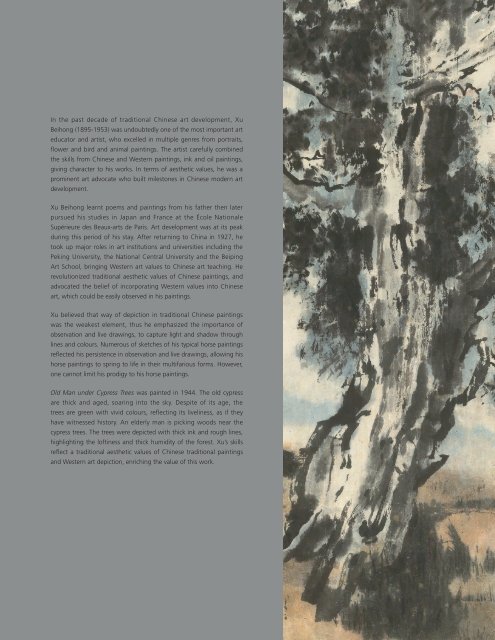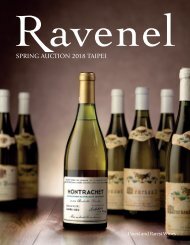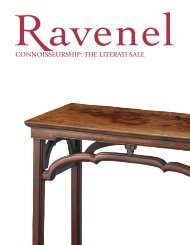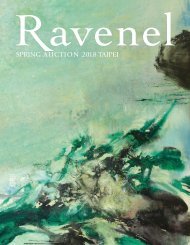翰墨丹青—中國書畫專場 Refined Brushwork: Fine Chinese Paintings
羅芙奧2018春季拍賣會 翰墨丹青—中國書畫專場 Ravenel Spring Auction 2018 Refined Brushwork: Fine Chinese Paintings
羅芙奧2018春季拍賣會 翰墨丹青—中國書畫專場
Ravenel Spring Auction 2018 Refined Brushwork: Fine Chinese Paintings
Create successful ePaper yourself
Turn your PDF publications into a flip-book with our unique Google optimized e-Paper software.
In the past decade of traditional <strong>Chinese</strong> art development, Xu<br />
Beihong (1895-1953) was undoubtedly one of the most important art<br />
educator and artist, who excelled in multiple genres from portraits,<br />
flower and bird and animal paintings. The artist carefully combined<br />
the skills from <strong>Chinese</strong> and Western paintings, ink and oil paintings,<br />
giving character to his works. In terms of aesthetic values, he was a<br />
prominent art advocate who built milestones in <strong>Chinese</strong> modern art<br />
development.<br />
Xu Beihong learnt poems and paintings from his father then later<br />
pursued his studies in Japan and France at the École Nationale<br />
Supérieure des Beaux-arts de Paris. Art development was at its peak<br />
during this period of his stay. After returning to China in 1927, he<br />
took up major roles in art institutions and universities including the<br />
Peking University, the National Central University and the Beiping<br />
Art School, bringing Western art values to <strong>Chinese</strong> art teaching. He<br />
revolutionized traditional aesthetic values of <strong>Chinese</strong> paintings, and<br />
advocated the belief of incorporating Western values into <strong>Chinese</strong><br />
art, which could be easily observed in his paintings.<br />
Xu believed that way of depiction in traditional <strong>Chinese</strong> paintings<br />
was the weakest element, thus he emphasized the importance of<br />
observation and live drawings, to capture light and shadow through<br />
lines and colours. Numerous of sketches of his typical horse paintings<br />
reflected his persistence in observation and live drawings, allowing his<br />
horse paintings to spring to life in their multifarious forms. However,<br />
one cannot limit his prodigy to his horse paintings.<br />
Old Man under Cypress Trees was painted in 1944. The old cypress<br />
are thick and aged, soaring into the sky. Despite of its age, the<br />
trees are green with vivid colours, reflecting its liveliness, as if they<br />
have witnessed history. An elderly man is picking woods near the<br />
cypress trees. The trees were depicted with thick ink and rough lines,<br />
highlighting the loftiness and thick humidity of the forest. Xu’s skills<br />
reflect a traditional aesthetic values of <strong>Chinese</strong> traditional paintings<br />
and Western art depiction, enriching the value of this work.







